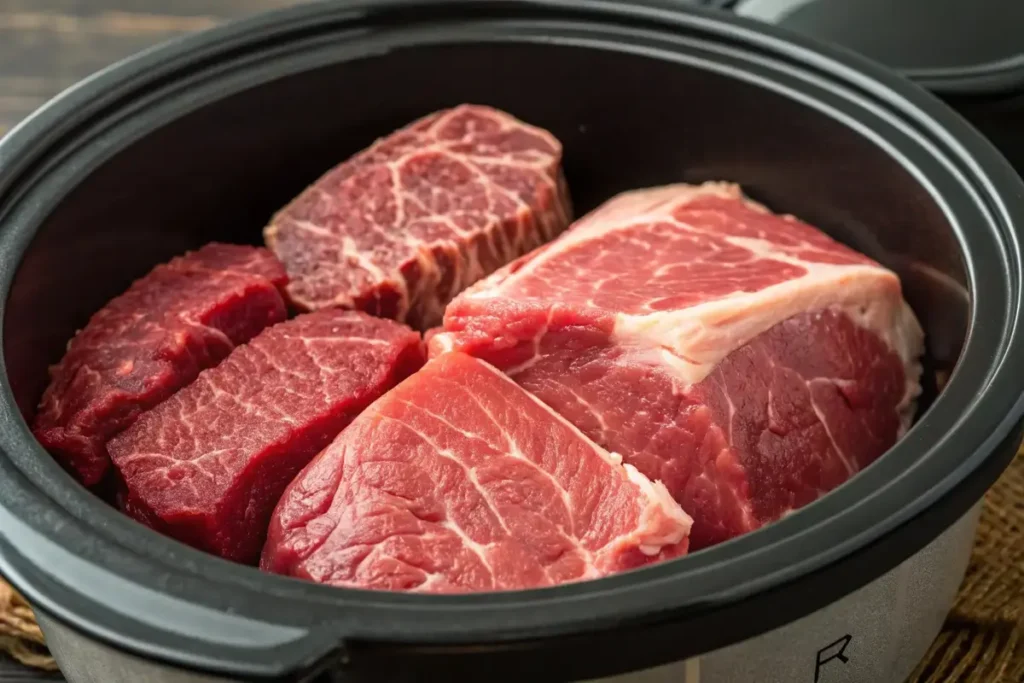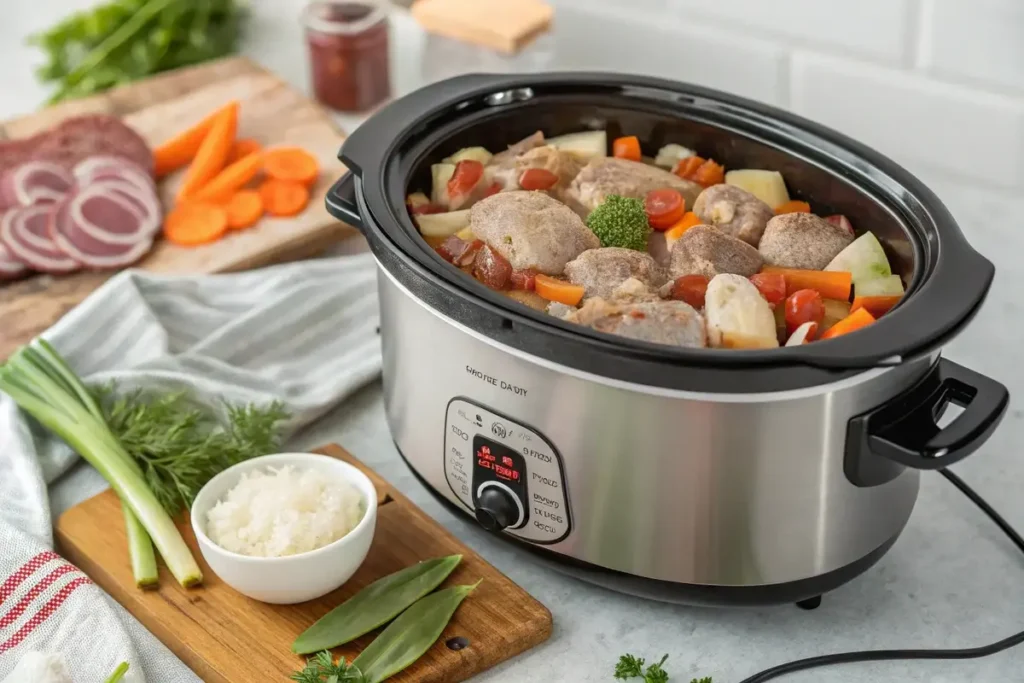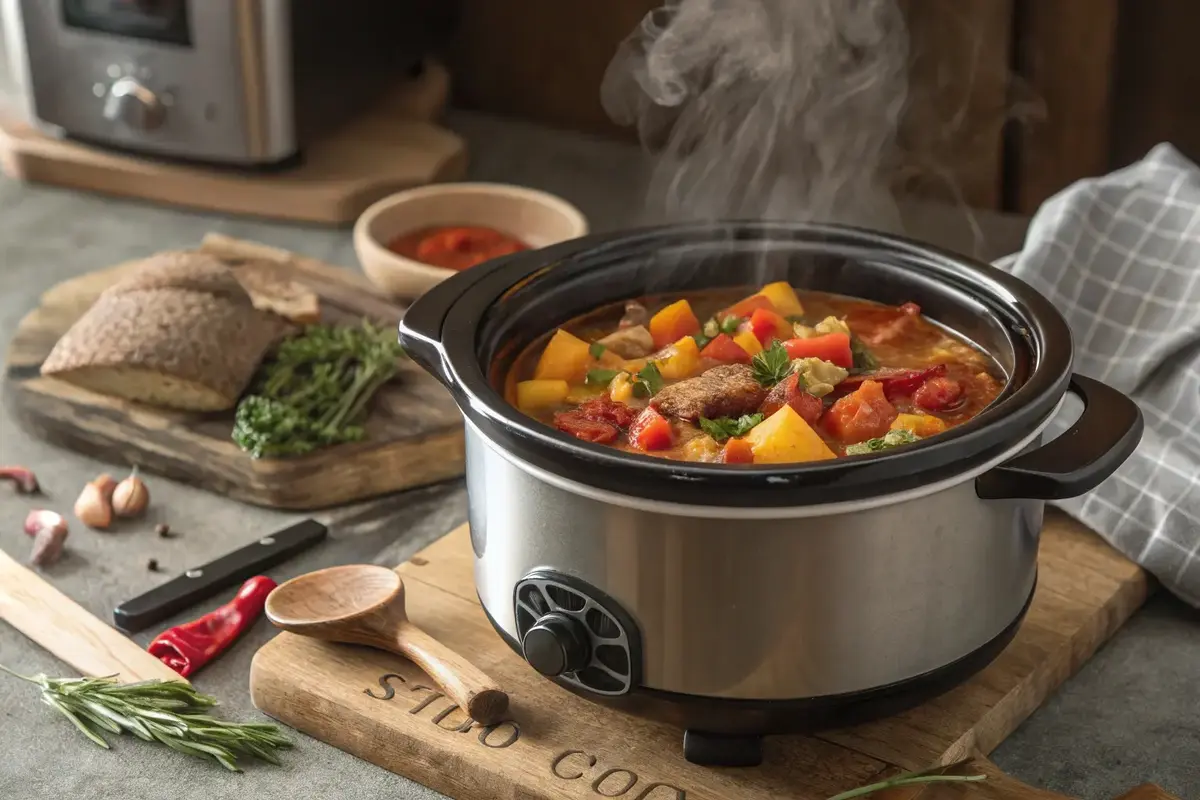What Are Some of the Mistakes People Make Using a Slow Cooker?
Slow cookers are a dream come true for busy cooks, offering a hands-off approach to preparing hearty, flavorful meals. Yet, even with the simplicity of these kitchen wonders, many people unknowingly fall into traps that ruin their dishes. From using the wrong ingredients to neglecting proper maintenance, these mistakes can turn your slow-cooking success into a disappointment. But don’t fret—this article will guide you through the most common slow cooker mistakes and how to avoid them, ensuring perfect results every time. Let’s dive in!
Common Slow Cooker Mistakes
Overfilling the Slow Cooker
One of the most frequent mistakes people make when using a slow cooker is overfilling it. While it might seem like a good idea to cram as much food as possible into the pot, this approach can backfire. Slow cookers work by circulating heat around the ingredients. When it’s too full, the food won’t cook evenly, and some parts might remain undercooked while others become mushy.
To avoid this, always follow the golden rule: fill the slow cooker no more than two-thirds full. This ensures that heat distributes evenly, and your ingredients have room to simmer properly. Trust us—giving your food space to “breathe” will lead to tastier results.
Not Preheating the Slow Cooker
Did you know that skipping preheating can throw off your cooking process? Starting with a cold slow cooker means your ingredients spend extra time in the “danger zone” (between 40°F and 140°F), where bacteria can thrive. This not only affects food safety but also the final flavor.
Instead, treat your slow cooker like an oven—preheat it for about 15-20 minutes before adding your ingredients. This simple step ensures even cooking from the very beginning, and it’s especially important when preparing dishes like soups or stews where every ingredient counts.
Using the Wrong Cut of Meat
Slow cookers excel at transforming tough cuts of meat into tender, melt-in-your-mouth perfection. However, using lean cuts like chicken breast or pork loin can lead to dry, flavorless results. Why? These cuts lack the connective tissue and fat that break down during slow cooking, which gives your dish that rich, tender texture.
Instead, opt for tougher cuts like chuck roast, brisket, or thighs. These meats thrive in a slow cooker’s moist heat, breaking down over time to create a juicy, satisfying dish. Don’t hesitate to ask your butcher for recommendations—they’re a goldmine of knowledge when it comes to selecting the right cuts.

Adding Too Much Liquid
It’s easy to overdo it with liquid when using a slow cooker. Unlike traditional cooking methods, slow cookers trap moisture inside, so there’s rarely any evaporation. If you add too much liquid, you may end up with a watery, bland dish.
The solution? Adjust recipes to suit the slow cooker. Use less broth, water, or sauce than you normally would. And if your dish turns out too soupy, thicken it with a slurry of cornstarch or flour at the end. A little mindfulness goes a long way in achieving the perfect consistency.
Lifting the Lid Frequently
We get it—waiting for your meal to cook can be exciting, and curiosity might tempt you to peek inside. But every time you lift the lid, you let out precious heat and moisture, significantly slowing down the cooking process. In fact, just one quick lift can set your dish back by 15-20 minutes!
To avoid this, rely on the slow cooker’s timer and trust the process. Resist the urge to check on your food constantly—your patience will pay off with a perfectly cooked meal. If you must stir, do it sparingly and quickly to minimize heat loss.
Ingredients and Timing Errors
Mistake 6: Adding Dairy Too Early
One of the most common blunders when using a slow cooker is adding dairy products—such as milk, cream, or cheese—too early in the cooking process. Dairy doesn’t hold up well to extended cooking times and high heat, which causes it to curdle, separate, or lose its creamy texture. Not only does this impact the flavor, but it can also leave your dish looking unappetizing.
To prevent this, always add dairy near the end of the cooking time, usually in the last 15-30 minutes. Whether you’re preparing a creamy soup or a cheesy casserole, this small adjustment ensures that the dairy remains smooth and perfectly blended, giving your dish that silky finish it deserves.
Mistake 7: Not Layering Ingredients Properly
Did you know that how you layer ingredients in a slow cooker can make or break your dish? Dense ingredients like potatoes, carrots, and root vegetables take longer to cook and need to be placed at the bottom, closest to the heat source. If you pile everything randomly, you may end up with unevenly cooked food, with some parts overdone and others undercooked.
For even cooking, always layer your ingredients strategically. Start with dense items like potatoes and carrots, followed by meats, and then place delicate ingredients like leafy greens or herbs on top. This method ensures that everything cooks at the right pace and your dish turns out perfectly balanced. If you’re cooking with liquids, pour them over the ingredients last to help everything cook evenly.

Mistake 8: Using Frozen Ingredients Without Thawing
Tossing frozen meat or vegetables directly into a slow cooker might seem like a shortcut, but it’s a risky move. Slow cookers take longer to reach safe cooking temperatures, and frozen ingredients can keep your food in the danger zone (40°F–140°F) for too long. This increases the risk of harmful bacteria growth, which can make your dish unsafe to eat.
To avoid this, always thaw frozen ingredients before adding them to your slow cooker. For meats, let them defrost overnight in the refrigerator. Vegetables can be thawed under cool running water or in the fridge. This small step ensures safe and even cooking, so you can enjoy your meal with peace of mind.
Mistake 9: Cooking on High When Low is Better
Many people think cooking on high heat will save time, but in a slow cooker, this often backfires. High heat can cause food to overcook or dry out, especially for delicate ingredients like chicken breasts or vegetables. It also reduces the tenderizing effect that slow cooking is known for.
In general, it’s better to cook on low whenever possible. The low setting allows flavors to develop and tougher cuts of meat to break down properly. Reserve the high setting for short cook times or recipes that call for it specifically. When in doubt, go low and slow—it’s called a slow cooker for a reason!
Cleaning and Maintenance Errors
Mistake 10: Neglecting to Clean Properly
A poorly cleaned slow cooker isn’t just unpleasant—it can also affect the taste and safety of your next meal. Lingering food residue or odors can mix with your new recipe, creating off flavors. Worse, bacteria can grow in hard-to-reach areas, especially in cracks or on the lid.
To keep your slow cooker in top shape, clean it thoroughly after every use. Allow it to cool completely, then wash the ceramic insert and lid with warm, soapy water. For stubborn residue, soak the insert and use a gentle sponge to avoid scratches. Don’t forget to clean the exterior and the heating element with a damp cloth. Regular cleaning not only ensures better-tasting food but also extends the life of your appliance.
Mistake 11: Using Abrasive Cleaners
While it might be tempting to scrub away tough stains with abrasive cleaners or steel wool, these can damage the ceramic insert’s non-stick surface. Over time, this makes it more prone to sticking and harder to clean.
Stick to gentle cleaning solutions like baking soda and water or a white vinegar soak for tough stains. Use a soft sponge or cloth to scrub without damaging the finish. With a little care, your slow cooker will stay looking and performing like new.
Mistake 12: Not Checking for Cracks or Damage
Even minor cracks in the ceramic insert or chips on the lid can cause big problems. Cracks can allow moisture to seep out, affecting cooking performance, while chips may harbor bacteria that’s difficult to clean. Plus, a damaged slow cooker can pose a safety risk, especially if it leads to uneven heating or leaks.
Inspect your slow cooker regularly for signs of wear and tear. Run your fingers along the edges of the insert to check for chips, and hold it up to the light to spot cracks. If you notice significant damage, it’s best to replace the affected parts or invest in a new slow cooker. It’s better to be safe than sorry!
Advanced Tips to Avoid Common Errors
How to Adapt Recipes for the Slow Cooker
Not all recipes are slow cooker-friendly right out of the gate. Adapting traditional recipes for this method of cooking requires a few adjustments to ensure success. Slow cookers operate at low temperatures and retain moisture, which means some techniques, like browning or reducing sauces, aren’t built into the process.
First, reduce the amount of liquid in recipes. Since slow cookers trap moisture, using the same amount of broth or water as you would in stovetop or oven recipes can result in overly soupy dishes. A good rule of thumb is to reduce liquid by about one-third.
Second, consider the timing of adding ingredients. Vegetables like zucchini or spinach should be added closer to the end of the cooking time to avoid turning mushy. Meanwhile, meats and root vegetables can handle the full duration. And if your recipe involves browning meat, don’t skip this step—it adds depth of flavor that the slow cooker can’t replicate. With a few tweaks, your favorite recipes can become slow-cooking staples.
Using a Meat Thermometer for Accuracy
One of the best tools for ensuring your slow-cooked meals are both delicious and safe is a meat thermometer. While slow cookers excel at tenderizing tough cuts of meat, they cook at low temperatures that can make it harder to confirm doneness by appearance alone.
To ensure food safety, use a meat thermometer to check that meats reach their recommended internal temperatures. For example, poultry should reach 165°F, while beef and pork should hit at least 145°F (with a rest period). Insert the thermometer into the thickest part of the meat without touching the bone for the most accurate reading.
This simple practice not only ensures safety but also keeps your meats perfectly cooked—no more dry chicken or overcooked roasts!
Frequently Asked Questions (FAQs)
Why does my slow cooker food always taste bland?
One common complaint about slow cooker meals is that they can taste bland. This often happens because seasonings lose their potency during the long cooking process. To avoid this, layer your seasonings. Add a portion of your spices or herbs at the beginning and adjust with fresh seasonings near the end of cooking. Ingredients like garlic, fresh herbs, or citrus zest are best added during the last 30 minutes to brighten up flavors. Don’t forget salt—it enhances flavors but can easily get lost in large, slow-cooked dishes. Taste and adjust before serving for a well-seasoned meal.
Can I leave a slow cooker on overnight?
Yes, you can safely leave a slow cooker on overnight, provided you follow a few precautions. Ensure your slow cooker is on a low setting, and avoid using recipes with dairy or quick-cooking ingredients that may overcook. Keep the cooker on a stable surface, away from walls or flammable materials, and double-check that your cord and plug are in good condition. Modern slow cookers with timers or automatic switches to “warm” mode are even safer for overnight use. This is perfect for dishes like stews or oatmeal that benefit from long cooking times.
How do I fix a watery slow cooker recipe?
If your slow cooker meal turns out too watery, don’t worry—there are easy fixes! One method is to make a slurry by whisking a tablespoon of cornstarch or flour with cold water, then stirring it into the dish and letting it cook for another 15–20 minutes on high. Alternatively, remove the lid during the last 30 minutes of cooking to allow excess moisture to evaporate. You can also use mashed potatoes, rice, or a thick paste made from pureed vegetables to thicken the liquid naturally.
Why is my meat dry after cooking in the slow cooker?
Dry meat is often the result of using lean cuts that lack sufficient fat or overcooking. For tender results, choose cuts like chuck roast, short ribs, or chicken thighs, which break down better in a moist, low-temperature environment. Avoid cooking meat for too long—stick to recipe guidelines and use a meat thermometer to check for doneness. Also, adding a little liquid or sauce to the cooker can help keep meat juicy and flavorful.
Should I brown meat before adding it to the slow cooker?
Absolutely! While browning meat isn’t required for every slow cooker recipe, it can elevate your dish significantly. Browning caramelizes the meat’s surface, adding depth and richness to the overall flavor. It also helps lock in juices and improves the texture. Simply sear your meat in a hot skillet with a bit of oil before transferring it to the slow cooker. The extra step might seem tedious, but it’s well worth the effort for a more flavorful dish.
Final Thoughts on Avoiding Slow Cooker Mistakes
Slow cookers are an incredibly versatile tool, but like any cooking method, they come with their own set of challenges. Avoiding these common mistakes—whether it’s preheating your slow cooker, using the right cuts of meat, or timing your ingredients correctly—can transform your meals from “just okay” to absolutely delicious.
Take the time to layer your ingredients properly, adjust your liquids, and use simple tricks like browning your meat or seasoning at the right moments. By doing so, you’ll not only enhance your cooking experience but also maximize the potential of your slow cooker.
Whether you’re a busy parent, a working professional, or just someone who loves a good home-cooked meal, understanding how to avoid these pitfalls will save you time and frustration. With these tips in mind, your slow cooker will become your most reliable kitchen companion, delivering flavorful, perfectly cooked meals every time.

